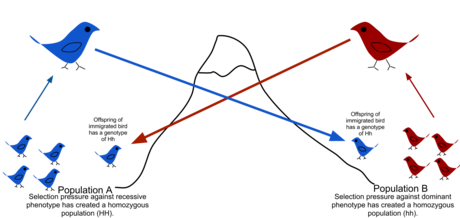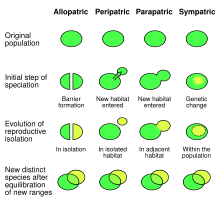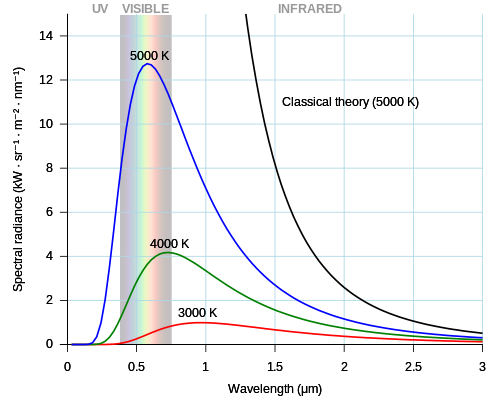Gene flow is the transfer of alleles from one population to another population through immigration of individuals.
In population genetics, gene flow (also known as gene migration or allele flow) is the transfer of genetic variation from one population
to another. If the rate of gene flow is high enough, then two
populations are considered to have equivalent allele frequencies and
therefore effectively be a single population. It has been shown that it
takes only "One migrant per generation" to prevent populations from
diverging due to drift.
Gene flow is an important mechanism for transferring genetic diversity
among populations. Migrants change the distribution of genetic
diversity within the populations, by modifying the allele frequencies
(the proportion of members carrying a particular variant of a gene).
High rates of gene flow can reduce the genetic differentiation between
the two groups, increasing homogeneity. For this reason, gene flow has
been thought to constrain speciation
by combining the gene pools of the groups, thus preventing the
development of differences in genetic variation that would have led to
full speciation. In some cases migration may also result in the addition of novel genetic variants to the gene pool of a species or population.
There are a number of factors that affect the rate of gene flow
between different populations. Gene flow is expected to be lower in
species that have low dispersal or mobility, that occur in fragmented
habitats, where there is long distances between populations, and when
there are small population sizes.
Mobility plays an important role in the migration rate, as highly
mobile individuals tend to have greater migratory prospects. Although
animals are thought to be more mobile than plants, pollen and seeds may
be carried great distances by animals or wind. When gene flow is
impeded, there can be an increase in inbreeding, measured by the inbreeding coefficient
(F) within a population. For example, many island populations have low
rates of gene flow due to geographic isolation and small population
sizes. The Black Footed Rock Wallaby
has several inbred populations that live on various islands off the
coast of Australia. The population is so strongly isolated that lack of
gene flow has led to high rates of inbreeding.
Measuring gene flow
Decrease
in population size leads to increased divergence due to drift, while
migration reduces divergence and inbreeding. Gene flow can be measured
by using the effective population size ()
and the net migration rate per generation (m). Using the approximation
based on the Island model, the effect of migration can be calculated for
a population in terms of the degree of genetic differentiation(). This formula accounts for the proportion of total molecular marker variation among populations, averaged over loci. When there is one migrant per generation, the inbreeding coefficient ()
equals 0.2. However, when there is less than 1 migrant per generation
(no migration), the inbreeding coefficient rises rapidly resulting in
fixation and complete divergence ( = 1). The most common
is less than 0.25. This means there is some migration happening. Measures of
population structure range from 0 to 1. When gene flow occurs via
migration the deleterious effects of inbreeding can be ameliorated.
The formula can be modified to solve for the migration rate when is known:
, Nm = number of migrants.
Barriers to gene flow
Allopatric speciation
Examples of speciation affecting gene flow.
When gene flow is blocked by physical barriers, this results in Allopatric speciation
or a geographical isolation that does not allow populations of the same
species to exchange genetic material. Physical barriers to gene flow
are usually, but not always, natural. They may include impassable
mountain ranges, oceans, or vast deserts. In some cases, they can be
artificial, man-made barriers, such as the Great Wall of China, which has hindered the gene flow of native plant populations. One of these native plants, Ulmus pumila, demonstrated a lower prevalence of genetic differentiation than the plants Vitex negundo, Ziziphus jujuba, Heteropappus hispidus, and Prunus armeniaca whose habitat is located on the opposite side of the Great Wall of China where Ulmus pumila grows. This is because Ulmus pumila has wind-pollination as its primary means of propagation and the latter-plants carry out pollination through insects.
Samples of the same species which grow on either side have been shown
to have developed genetic differences, because there is little to no
gene flow to provide recombination of the gene pools.
Sympatric speciation
Barriers
to gene flow need not always be physical. Sympatric speciation happens
when new species from the same ancestral species arise along the same
range. This is often a result of a reproductive barrier. For example,
two palm species of Howea found on Lord Howe Island were found to
have substantially different flowering times correlated with soil
preference, resulting in a reproductive barrier inhibiting gene flow.
Species can live in the same environment, yet show very limited gene
flow due to reproductive barriers, fragmentation, specialist
pollinators, or limited hybridization or hybridization yielding unfit
hybrids. A cryptic species is a species that humans cannot tell is
different without the use of genetics. Moreover, gene flow between
hybrid and wild populations can result in loss of genetic diversity via genetic pollution, assortative mating and outbreeding. In human populations, genetic differentiation can also result from endogamy, due to differences in caste, ethnicity, customs and religion.
Human assisted gene-flow
Genetic rescue
Gene
flow can also be used to assist species which are threatened with
extinction. When a species exist in small populations there is an
increased risk of inbreeding and greater susceptibility to loss of
diversity due to drift. These populations can benefit greatly from the
introduction of unrelated individuals who can increase diversity and
reduce the amount of inbreeding, and thus increase overall fitness. This
was demonstrated in the lab with two bottleneck strains of drosophila melanogaster,
in which crosses between the two populations reversed the effects of
inbreeding and led to greater chances of survival in not only one
generation but two.
Genetic pollution
Human activities such as movement of species and modification of landscape can result in genetic pollution, hybridization, introgression and genetic swamping. These processes can lead to homogenization or replacement of local genotypes as a result of either a numerical and/or fitness advantage of introduced plant or animal.
Nonnative species can threaten native plants and animals with
extinction by hybridization and introgression either through purposeful
introduction by humans or through habitat modification, bringing
previously isolated species into contact. These phenomena can be
especially detrimental for rare species coming into contact with more
abundant ones which can occur between island and mainland species.
Interbreeding between the species can cause a 'swamping' of the rarer
species' gene pool, creating hybrids that supplant the native stock.
This is a direct result of evolutionary forces such as natural
selection, as well as genetic drift, which lead to the increasing
prevalence of advantageous traits and homogenization. The extent of this
phenomenon is not always apparent from outward appearance
alone. While some degree of gene flow occurs in the course of normal
evolution, hybridization with or without introgression may threaten a
rare species' existence. For example, the Mallard
is an abundant species of duck that interbreeds readily with a wide
range of other ducks and poses a threat to the integrity of some
species.
Gene flow between species
Horizontal gene transfer
Horizontal gene transfer (HGT) refers to the transfer of genes
between organisms in a manner other than traditional reproduction,
either through transformation (direct uptake of genetic material by a cell from its surroundings), conjugation (transfer of genetic material between two bacterial cells in direct contact), transduction (injection of foreign DNA by a bacteriophage virus into the host cell) or GTA-mediated transduction (transfer by a virus-like element produced by a bacterium).
Viruses can transfer genes between species. Bacteria can incorporate genes from dead bacteria, exchange genes with living bacteria, and can exchange plasmids across species boundaries.
"Sequence comparisons suggest recent horizontal transfer of many genes among diverse species including across the boundaries of phylogenetic
'domains'. Thus determining the phylogenetic history of a species can
not be done conclusively by determining evolutionary trees for single
genes."
Biologist Gogarten suggests "the original metaphor of a tree no
longer fits the data from recent genome research". Biologists [should]
instead use the metaphor of a mosaic to describe the different histories
combined in individual genomes and use the metaphor of an intertwined
net to visualize the rich exchange and cooperative effects of horizontal
gene transfer.
"Using single genes as phylogenetic markers, it is difficult to trace organismal phylogeny in the presence of HGT. Combining the simple coalescence model of cladogenesis with rare HGT events suggest there was no single last common ancestor that contained all of the genes ancestral to those shared among the three domains of life. Each contemporary molecule has its own history and traces back to an individual molecule cenancestor. However, these molecular ancestors were likely to be present in different organisms at different times."
Hybridization
In
some instances, when a species has a sister species and breeding
capabilities are possible due to the removal of previous barriers or
through introduction due to human intervention, species can hybridize
and exchange genes and corresponding traits. This exchange is not always
clear-cut, for sometimes the hybrids may look identical to the original
species phenotypically but upon testing the mtDNA it is apparent that
hybridization has occurred. Differential hybridization also occurs
because some traits and DNA are more readily exchanged than others, and
this is a result of selective pressure or the absence thereof that
allows for easier transaction. In instances in which the introduced
species begins to replace the native species, the native species becomes
threatened and the biodiversity is reduced, thus making this phenomenon
negative rather than a positive case of gene flow that augments genetic
diversity. Introgression is the replacement of the native species genes
with that of the invader species. It is important to note that hybrids
are generally deemed less "fit" than their parental generation, and as a
result is a closely monitored genetic issue as the ultimate goal in
conservation genetics is to maintain the genetic integrity of a species
and preserve biodiversity.
Examples
Marine iguana of the Galapagos Islands evolved via allopatric speciation, through limited gene flow and geographic isolation.
While
gene flow can greatly enhance the fitness of a population, it can also
have negative consequences depending on the population and the
environment in which they reside. The effects of gene flow are
context-dependent.
- Fragmented Population: fragmented landscapes such as the Galapagos Islands are an ideal place for adaptive radiation to occur as a result of differing geography. Darwin's Finches likely experienced allopatric speciation in some part due to differing geography, but that doesn't explain why we see so many different kinds of finches on the same island. This is due to adaptive radiation, or the evolution of varying traits in light of competition for resources. Gene flow moves in the direction of what resources are abundant at a given time.
- Island Population: The Marine Iguana is an endemic species of the Galapagos Islands, but it evolved from a mainland ancestor of land iguana. Due to geographic isolation gene flow between the two species was limited and differing environments caused the Marine Iguana to evolve in order to adapt to the island environment. For instance, they are the only iguana that has evolved the ability to swim.
- Human Populations: Two theories exist for the human evolution throughout the world. The first is known as the multiregional model in which modern human variation is seen as a product of radiation of Homo erectus out of Africa after which local differentiation led to the establishment of regional population as we see them now. Gene flow plays an important role in maintaining a grade of similarities and preventing speciation. In contrast the single origin theory assumes that there was a common ancestral population originating in Africa of Homo sapiens which already displayed the anatomical characteristics we see today. This theory minimizes the amount of parallel evolution that is needed.
- Butterflies: Comparisons between sympatric and allopatric populations of Heliconius melpomene, H. cydno, and H. timareta revealed a genome-wide trend of increased shared variation in sympatry, indicative of pervasive interspecific gene flow.
- Human-mediated gene flow: The captive genetic management of threatened species is the only way in which humans attempt to induce gene flow in ex situ situation. One example is the Giant Panda which is part of an international breeding program in which genetic materials are shared between zoological organizations in order to increase genetic diversity in the small populations. As a result of low reproductive success, artificial insemination with fresh/frozen-thawed sperm was developed which increased cub survival rate. A 2014 study found that high levels of genetic diversity and low levels of inbreeding were estimated in the breeding centers.
- Plants: Two species of Monkeyflowers, mimulus lewsii and mimulus cardinalis, were found to have highly specialized pollinators that acted on major genes resulting in a contribution to the floral evolution and reproductive isolation of these two species. The specialized pollination limited gene flow between the two species, eventually resulting in two different species.
- Sika deer: Sika deer were introduced into Western Europe, and they reproduce easily with the native red deer. This translocation of Sika deer has led to introgression and there are no longer "pure" red deer in the region, and all can be classified as hybrids.
- Bobwhite quail: Bobwhite quail were translocated from the southern part of the United States to Ontario in order to increase population numbers and game for hunting.The hybrids that resulted from this translocation was less fit than the native population and were not adapted to survived the Northern Winters.







